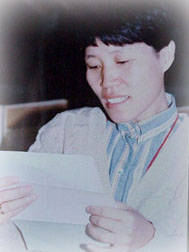The Poet through the Writings of Na Hee Duk
"The problem that enthralls me is the cultural crisis and intellectual roots of our times. I do not distinguish ideal from reality in my mind, and cannot separate the political reality from the artistic spirit. Life and ideas are two sides of the same coin. 'Reality' is the lens I use to search for dreams. And the search goes on"

Poet Na Hee Duk recently published an article entitled 'The Hand that Cuts the Cloth of our Times' in the summer edition ofCreation and Criticism. The article is about the philosophy of the late poet Go. In it, Na "pays tribute to the footprints of a spirit that withstood the winds of the 80s," and says, "Poet Go deserves critical acclaim for breaking away from the narrow framework of lyrical poetry to pursue the possibilities of new forms, and for setting free political and sexual taboos that the negative reality imposed on poetic expression."
Go started out from a Christian point of view, moved to infuse poetry into the people's struggle, and finally broadened her poetic realm to include the world of feminism. Na summarized the poet's world into three themes Christianity, People, and Women.
According to Na, the late poet began to embrace feminist themes with her work 'Green Grass on That Grave' (1989). Unlike her initial works, which had taken a romantic approach to femininity, her poems from that time on portrayed mothers the prototype of femininity as the representative of suffering women and the main player of history. She fused the misfortune of national division and the history of women, and her intellectual labor bore fruits such as 'Fourth Story Repose of Souls' and 'As for the Origin of Humans.'
Go revealed her deep perception of feminist ideas and ventured into a variety of poetic methods through a later work entitled 'Women's Liberation Inauguration.' She broadened the horizon of feminist poetry by sending letters to and chatting with historical women such as Sin Sa Im Dang and Hwang Jin Ee.
For a long time, Go agonized over harmonizing people and women, practice and theory, literature and activism. Later, she traveled to the Philippines and Thailand to meet liberated and progressive women, and came to realize the patriarchal and rigid mentality of the people's movement. This led her to ponder ways to combine the feminist movement with the democratic movement and get the former to transform the climate of the latter. Amidst her muses, she also explored a new paradigm of the feminist movement.
The new paradigm she hit upon was 'Feminist Realism and the Revolution of Literary Style.' But just as she was about to launch into this new theme, her short life of 43 years came to an end in Baemsa Valley of Mt. Jiri.
Na writes, "Her posthumous work reveals a poet who knew how to slow down and look back. It is lamentable that right when she was about to delve deeper into her new creative niche, she suddenly left us"

